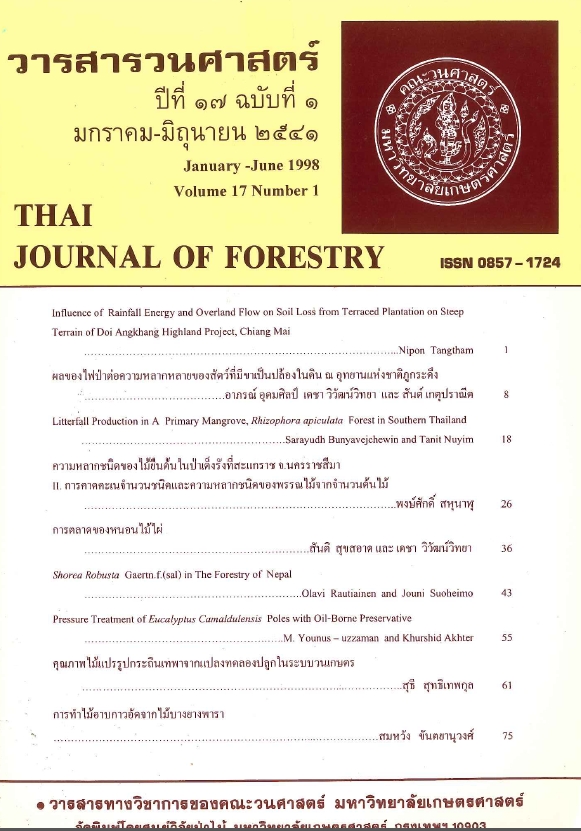การทำไม้อาบกาวอัดจากไม้บางยางพารา
Main Article Content
บทคัดย่อ
การศึกษาเพื่อพัฒนาการผลิตไม้อาบกาวอัดจากไม้บางยางพารา (Hevea brasiliensis Muell & Agr.) ได้ทำการศึกษาปัจจัยที่มีผลต่อการซึมซาบของเนื้อกาวสังเคราะห์เข้าสู่เนื้อไม้บางยางพารา 3 ปัจจัย คือปริมาณความเข้มข้นของสารละลายกาวฟีนอล ฟอร์มัลดีไฮต์ ที่ร้อยละ 20, 30 และ 40 ระยะเวลาการแช่ที่ 5, 10 และ 15 ชั่วโมง และสภาวะของไม้บางยางพาราที่สภาวะสดและสภาวะผึ่งแห้งโดยใช้แผนการทดลองแบบแฟคทอเรียล (สุ่มตลอดอย่างสมบูรณ์) ผลการศึกษาพบว่า ไม้บางยางพาราสด แช่ในสารละลายกาวฟีนอล ฟอร์มัลดีไฮต์ ความเข้มข้นร้อยละ 40 เป็นระยะเวลา 10 ชั่วโมง มีความเหมาะสมต่อการผลิตไม้อาบกาวอัด เพราะมีปริมาณเนื้อกาวที่ซึมซาบเข้าสู่เนื้อไม้บางยางพาราร้อยละ 33.18 จากการทดสอบแรงดัดสถิตย์ของชิ้นตัวอย่างตามมาตรฐาน ASTM พบว่า ไม้อาบกาวอัดแบบเสี้ยนขนานมีค่าเฉลี่ยมอดุลัสแตกร้าว เท่ากับ 126.16 เมกะปาสคาล ค่าเฉลี่ยมอดุลัสยืดหยุ่นเท่ากับ 14.22 จีกะปาสคาล สูงกว่าค่าเฉลี่ยมอดุลัสแตกร้าว และมอดุลัสยืดหยุ่น ของไม้อาบกาวอัดแบบเสี่ยนตั้งฉาก และไม้ยางพาราอย่างมีนัยสำคัญยิ่ง (P <0.01) ค่าเฉลี่ยมอดุลัสความแข็งของไม้อาบกาวอัดแบบเสียนตั้งนากเท่ากับ 98.32 เมกะปาสคาล แตกต่างจากค่าเฉลียมอดุลัสความแข็งของไม้อาบกาวอัดแบบเสียนขนาน ซึ่งมีค่าเท่ากับ 87.38 เมกะปาสคาล อย่างไม่มีนัยสำคัญ (P <0.05) ทั้งนี้ค่าเฉลี่ยมอดุลัสความแข็งของไม้อาบกาวอัดทั้งสองแบบมีค่าสูงกว่าค่าความแข็งของไม้ยางพารา (ด้านสัมผัส) ซึ่งมีค่าเท่ากับ 38.54 เมกะปาสคาลอย่างมีนัยสำคัญยิ่ง สกายสมบัติของไม้อาบกาวอัดทั้งสองแบบ เช่น ความถ่วงจำเพาะ การดูดซึมน้ำ การพองตัวบวกการคืนตัว และการคืนตัวตามความหนา มีความแตกต่างกันอย่างไม่มีนัยสำคัญ โดยการพองตัวบวกการคืนตัวตามความหนาของไม้อาบกาวอัดที่ศึกษา มีค่าใกล้เคียงกับไม้อาบกาวอัดของต่างประเทศ และมีกลสมบัติที่ต่ำกว่าไม่มากนัก
Downloads
Article Details

อนุญาตภายใต้เงื่อนไข Creative Commons Attribution-NonCommercial-NoDerivatives 4.0 International License.
ข้าพเจ้าและผู้เขียนร่วม (ถ้ามี) ขอรับรองว่า ต้นฉบับที่เสนอมานี้ยังไม่เคยได้รับการตีพิมพ์และไม่ได้อยู่ในระหว่างกระบวนการพิจารณาตีพิมพ์ลงในวารสารหรือสิ่งตีพิมพ์อื่นใด ข้าพเจ้าและผู้เขียนร่วม (ถ้ามี) ยอมรับหลักเกณฑ์และเงื่อนไขการพิจารณาต้นฉบับ ทั้งยินยอมให้กองบรรณาธิการมีสิทธิ์พิจารณาและตรวจแก้ต้นฉบับได้ตามที่เห็นสมควร พร้อมนี้ขอมอบลิขสิทธิ์ผลงานที่ได้รับการตีพิมพ์ให้แก่วารสารวนศาสตร์ คณะวนศาสตร์ มหาวิทยาลัยเกษตรศาสตร์ กรณีมีการฟ้องร้องเรื่องการละเมิดลิขสิทธิ์เกี่ยวกับภาพ กราฟ ข้อความส่วนใดส่วนหนึ่ง หรือ ข้อคิดเห็นที่ปรากฏในผลงาน ให้เป็นความรับผิดชอบของข้าพเจ้าและผู้เขียนร่วม (ถ้ามี) แต่เพียงฝ่ายเดียว และหากข้าพเจ้าและผู้เขียนร่วม (ถ้ามี) ประสงค์ถอนบทความในระหว่างกระบวนการพิจารณาของทางวารสาร ข้าพเจ้าและผู้เขียนร่วม (ถ้ามี) ยินดีรับผิดชอบค่าใช้จ่ายทั้งหมดที่เกิดขึ้นในกระบวนการพิจารณาบทความนั้น”


